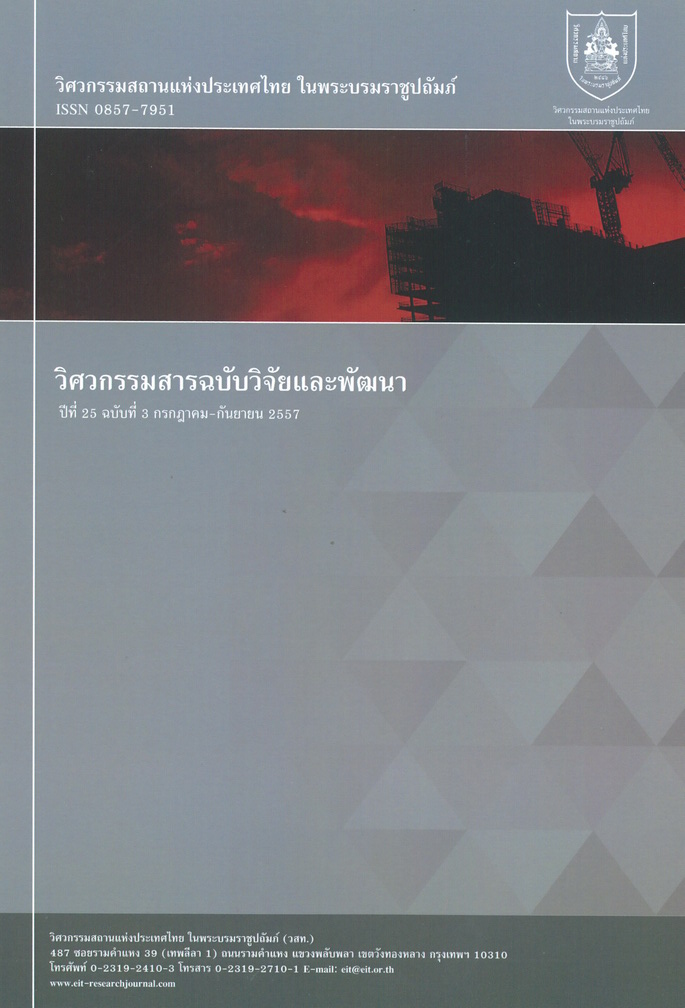DEFECTIVE REDUCTION FROM WELDING SPLASH IN MOTORCYCLE BATTERY PRODUCTION PROCESS
Main Article Content
Abstract
งานวิจัยนี้มีวัตถุประสงค์เพื่อปรับปรุงประบวนการผลิตเพื่อลดปริมาณของเสียที่เกิดจากปัญหาเย็บระเบิดในกระบวนการเชื่อมสะพานไฟของแบตเตอรี่รถจักรยานยนต์ โดยการประยุกต์แนวคิด ซิกซ์ ซิกมา งานวิจัยเริ่มจากการนิยามปัญหา ต่อมาในเฟสการวัดเพื่อกำหนดสาเหตุของปัญหาได้เลือกปัจจัยนําเข้าหลักมาพิสูจน์ความมีนัยสําคัญในเฟสการวิเคราะห์สาเหตุของปัญหาโดยใช้การออกแบบการทดลองแบบเชิงแฟคตอเรียล 2k แบบ 2 เรพลิเคต ซึ่งพบว่าปัจจัยที่มีผลต่อการเกิดแบตเตอรี่เย็บระเบิดอย่างมีนัยสำคัญ ประกอบด้วยปัจจัยหลัก คือ ระยะกดของหัว Tip แรงดันลม และกระแสไฟฟ้า และอันตรกิริยาระหว่างคู่ปัจจัย คือ แรงดันลม กับ กระแสไฟฟ้า หลังจากนั้นจึงนำปัจจัยที่มีผลดังกล่าวมาวิเคราะห์ด้วยวิธีพื้นผิวผลตอบเพื่อหาค่าที่เหมาะสมสำหรับนำไปใช้ในการตั้งค่าเครื่องเชื่อมสะพานไฟ ซึ่งพบว่าควรตั้งพารามิเตอร์ของกระบวนการดังนี้ ระยะกดของหัว Tip ที่ 1 มม. แรงดันลมที่ 30.6 Kg./cm2. และกระแสไฟฟ้าที่ 8.86 KA. ผลหลังการปรับปรุงพบว่าสัดส่วนของเสียจากปัญหาเย็บระเบิดลดลงเฉลี่ยจาก 3.61% เหลือเพียง 0.11% เท่านั้น
This research has the objectives to defective reduction from welding splash problem in motorcycle battery production process. The Six Sigma approach was applied to solve this problem. Firstly, the problem statement was defined. Next, find out the major cause of the defective problem. This research applied the design of experiment (DOE) technique by using the 2k full factorial design with two replicates for screening out the factors, founding top three factors which impact to the defective percentage, including stopper distance of tip, pressure and current, then used the Response Surface Methodology to optimize the level of significant factors. Founding optimal machine setting should be 1 mm. of the stopper distance of tip, 30.6 Kg/cm2 of the pressure and 8.86 KA. After improvement, the defective rate from welding splash defect was decreased from 3.61% to 0.11%.
Article Details
The published articles are copyright of the Engineering Journal of Research and Development, The Engineering Institute of Thailand Under H.M. The King's Patronage (EIT).

